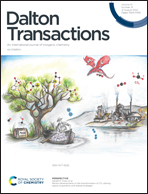Deaggregation properties and transmetalation studies of a zinc(ii) salen-type Schiff-base complex†
Abstract
This paper reports the synthesis and the deaggregation properties of a Lewis acidic Zn(II) salen-type Schiff-base complex derivative from diaminomaleonitrile and a systematic detailed study of its transmetalation with other metal ions in solution. In a solution of non-coordinating solvents, the complex is in a dimeric form, while in coordinating solvents or upon addition of a Lewis base it is stabilized as monomeric adducts. Experiments done in two solvents with different Lewis basicities indicate a major role of the stability of the starting adduct in transmetalation. Thus, using nitrate or perchlorate salts, acetonitrile solutions of the complex give an immediate and complete transmetalation with Cu2+, while with Co2+ and Ni2+ a much slower transmetalation rate is observed. Instead, using chloride salts a fast and complete transmetalation is observed for divalent ions of the first transition series (Mn2+, Fe2+, Co2+, Ni2+, Cu2+), indicating the role of the chloride in stabilizing the transition state of the transmetalation. On the other hand, DMF solutions of the complex are less prone to transmetalation, according with the greater basicity of the solvent and, hence, the greater stability of the related adducts with the complex. Therefore, the nature of the solvent and the counteranion allow controlling the transmetalation process of this Zn(II) Schiff-base complex.



 Please wait while we load your content...
Please wait while we load your content...